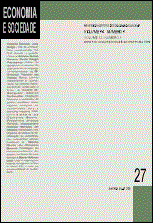Resumo
Neste trabalho procuramos criticar, numa perspectiva sraffiana, a tese de que teria havido uma bemsucedida contração fiscal expansionista nos EUA derivada do ajuste fiscal feito pelo governo Clinton a partir de 1993. Nem o ajuste fiscal reduziu diretamente os juros nem a queda dos juros aumentou diretamente o investimento produtivo. Longe de ser uma conseqüência automática do ganho de “credibilidade” obtido pelo ajuste fiscal, a recuperação e o prolongado período de crescimento foram frutos do viés expansionista da política monetária
Abstract
In this paper we try to criticize, from a Sraffian standpoint, the thesis according to which an expansionary fiscal contraction resulted from the US fiscal adjustment started in 1993 by the Clinton administration. Neither fiscal consolidation directly reduced interest rates, nor did interest rate reduction directly increase productive investment. Instead of being an automatic consequence of the “credibility” gains obtained from fiscal consolidation, the recovery and prolonged growth of the U.S. economy in the 1990s were due to the markedly expansionary bias of monetary policy.
Key words: Expansionary fiscal contraction. Sraffian supermultiplier. Monetary policy – United States
Referências
ASPROMOURGOS, T. Interest as an artifact of self validating central bank beliefs. University of Sidney. School of Economics and Political Science, 2005. Mimeografado.
BARBA, A. Rethinking expansionary fiscal retrenchments. Contributions to Political Economy, 20, 2001.
BERNANKE, B. Reflections on the yield curve and monetary policy. Speech to the Economic Club of New York, Mar. 20, 2006. Disponível em: .
BLINDER, A. Is there a core of practical macroeconomics that we should all believe? American Economic Review, May 1997.
________. Bancos Centrais: teoria e prática. São Paulo: editora 34, 1999.
________; YELLEN, J. The fabulous decade: macroeconomic lessons from the 1990s. Century Foundation Press, 2001.
BOMFIM, A. Monetary policy and the yield curve. New York: Federal Reserve Board 2003. Mimeografado.
BORTIS, H. Institutions, behavior and economic theory – A contribution to classicalKeynesian political economy. Cambridge, Mass.: Cambridge University Press, 1997.
BRAGA, J. Raiz unitária, histerese, inércia e a controvérsia sobre a mudança da NAIRU na década de 90 na economia norte americana. Tese (Doutorado)–Instituto de Economia da Universidade Federal do Rio de Janeiro, maio 2006.
CABALLERO, R. Aggregate investment. In: TAYLOR, J. B.; WOODFORD, M. (Ed.). Handbook of macroeconomics. North-Holland, 1999. chapt. 12.
CESARATTO S.; SERRANO F.; STIRATI. Technical change, effective demand and employment. Review of Political Economy, v. 15, n. 1, Jan. 2003.
CHIRINKO, R. S. Business fixed investment: a critical survey of modeling strategies, empirical results, and policy implications. Journal of Economic Literature, 31, p. 1875- 1911, 1993.
DE LONG, J. America’s historical experience with low inflation. University of California at Berkeley, Nov. 1999.
GALBRAITH, J. The fiscal facts: public and private debts and the future of the American economy. Levy Institute, 2006. (Levy Institute Policy Note 2006/2).
GALE, W.; ORZAG, P. Budget deficits, national saving, and interest rates. Brookings Papers on Economic Activity, Sept. 2004.
GAREGNANI (1978/79). Notes on consumption, investment and effective demand. In: EATWELL, J.; MILGATE (Ed.). Keynes’s economics and the theory of value and distribution. Duckworth, London, 1983.
GODLEY, W.; IZURIETA, A. Balances, imbalances and fiscal targets: a new Cambridge view. CERF Cambridge Endowment for Research in Finance, University of Cambridge, 2004.
HASSETT, K.; HUBBARD, G. Tax policy and investment. In: AUERBACH, Alan; FELDSTEIN, Martin (Ed.). Handbook of public economics. North-Holland, 2002. v. 3.
MAFFEO, V. Effective demand versus wage flexibility: some notes on the causes of the growth of employment in the USA in the nineties. Contributions to Political Economy, 20, 2001.
MAKI, D. The growth of consumer credit and the household debt service burden. Federal Reserve Board, Feb. 2000. (Finance and Economics Discussion Series).
________; PALUMBO, M. Disentangling the wealth effect: a cohort analysis of household saving in the 1990s. Federal Reserve Board, Apr. 2001. In: PETRI, Fabio; HAHN, Frank (Ed.). General equilibrium theory. Routledge, 2003. (Finance and Economics Discussion Series).
PETRI, F. General equilibrium, capital and macroeconomics. A key to recent controversies in equilibrium theory. Edward Elgar, 2004.
PIVETTI, M. An essay on money and distribution. London: Macmillan, 1991.
________. Money endogeneity and monetary non-neutrality: a Sraffian perspective. In: VERNENGO, M.; ROCHON, L. (Ed.). Credit, interest rate and the open economy. Edward Elgar, 2001.
POLLIN, R. Anatomy of Clintonomics. New Left Review, 3, May/Jun. 2000.
POLLIN, R. Wage bargaining and the US Phillips curve: was Greenspan right about traumatized workers in the 90s? Amherst: University of Massachusetts. Political Economy Research Institute, 2002. Mimeografado.
SERRANO, F. A soma das poupanças determina o investimento? Archetypon, 2000.
________. Acumulação e gasto improdutivo na economia do desenvolvimento. In: FIORI, J.; MEDEIROS, C. (Ed.). Polarização mundial e crescimento. Petrópolis: Vozes, 2001a.
________. Equilíbrio neoclássico de mercado de fatores: uma crítica do ponto de vista Sraffiano. Ensaios FEE, Porto Alegre, v. 22, n. 1, 2001b.
________. Do ouro imóvel ao dólar flexível. Economia e Sociedade, Campinas, v. 11, n. 2, 2002a.
________. A política monetária e a abordagem da taxa de juros exógena. Rio de Janeiro: Universidade Federal do Rio de Janeiro – UFRJ, 2002b. Mimeografado.
________. Relações de poder e a política macroeconômica americana, de Bretton Woods ao padrão dólar flexível. In: FIORI, J. L. (Org.). O poder americano. Petrópolis: Vozes, 2004.
STIGLITZ, J. The roaring nineties: A new history of the world’s most prosperous decade. New York: W. W. Norton & Company, 2003.
________; GREENWALD, B. Towards a new paradigm in monetary economics. Cambridge University Press, 2003.
A Economia e Sociedade utiliza a licença do Creative Commons (CC), preservando assim, a integridade dos artigos em ambiente de acesso aberto.

